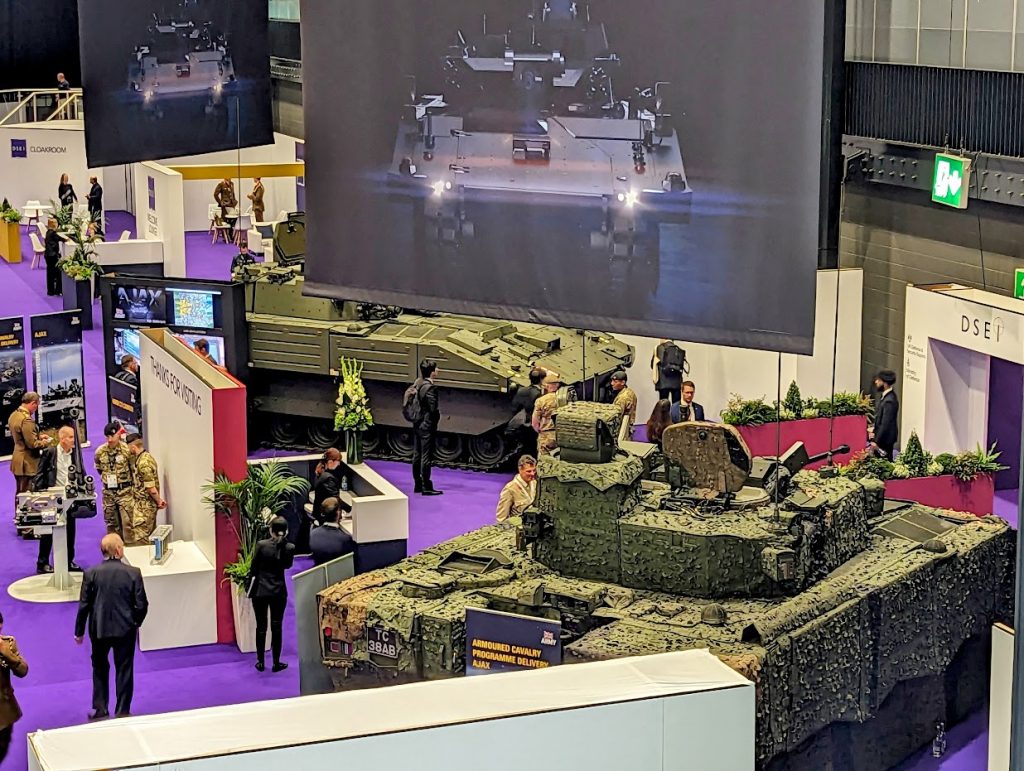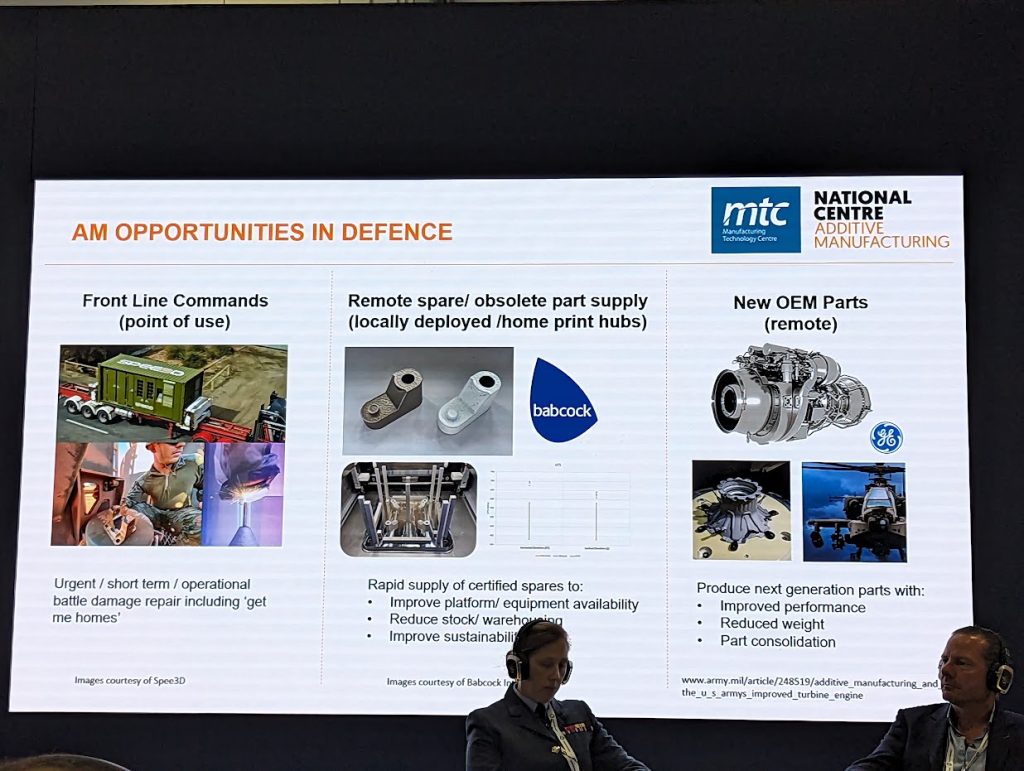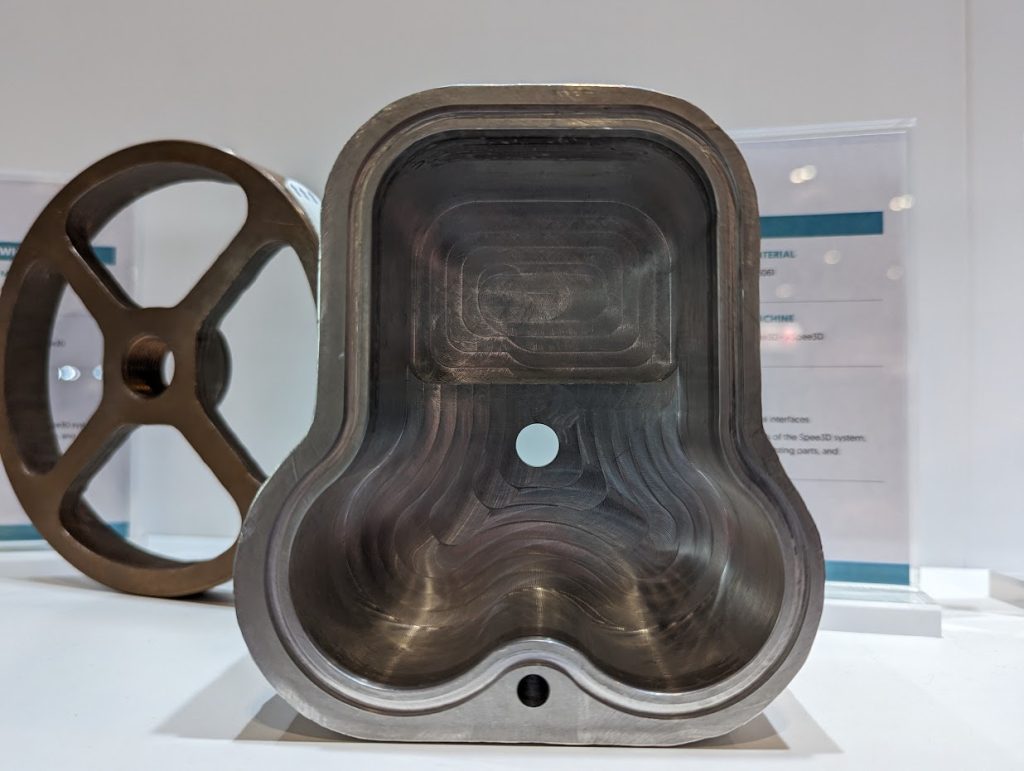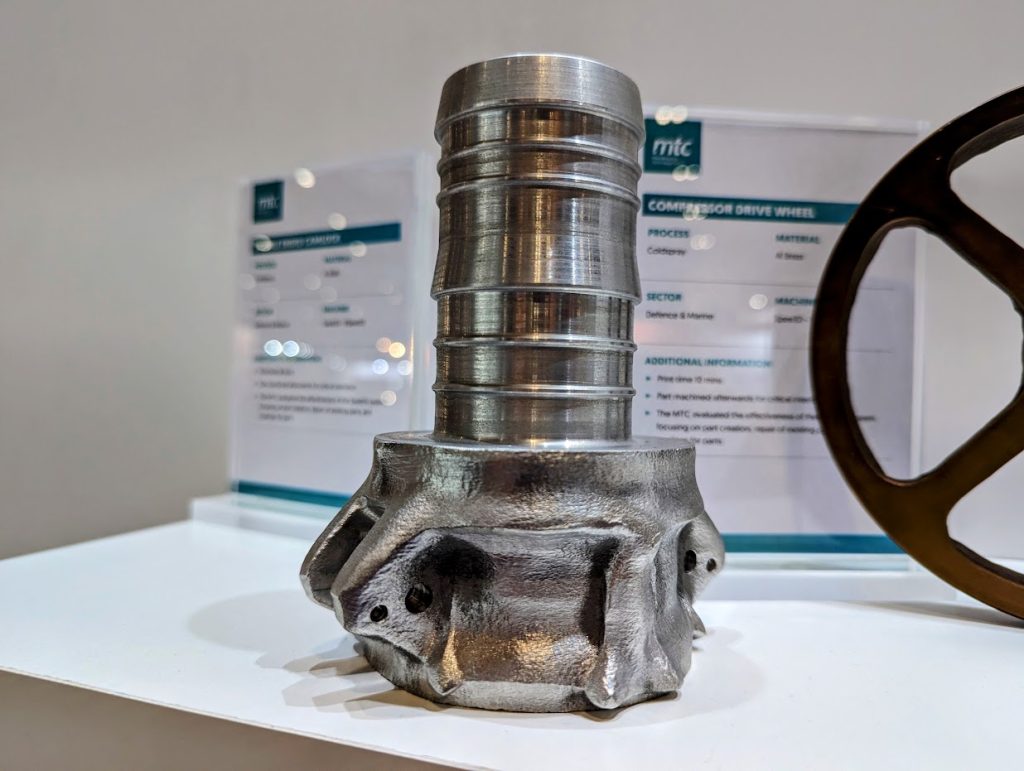I attended Europe’s largest defense and security event, DSEI, to hear how the sector uses additive manufacturing.
“Ten-minute warning” is not a phrase you hope to hear at an event jammed to the rafters with military hardware, surrounded by at least a brigade’s worth of officers from worldwide militaries, and several new vehicles from the British Army’s £5.5 billion Ajax program. Fortunately, this call was issued to wrap up a discussion panel headed by the MTC’s Andy Barnes on Additive manufacture at point of use: Challenges and opportunities.

“Additive manufacturing started out as a rapid prototyping technology. Over recent years, additive has moved much more into the mainstream for new component applications,” began Dr. Ross Trepleton, Associate Director – Technology Strategy at MTC. The world is moving from viewing additive manufacturing as a prototype system to embracing it as a tool for innovative solutions.
He showcased intriguing examples: a GE midframe structure that eliminated the need for 300 parts from 50 different sources and a space application antenna that consolidated 100 parts into one, resulting in a sizeable 95% savings. Notably, the U.S. hearing aid sector demonstrated a robust shift, with the entire supply chain converting to additive manufacturing within 500 days, leaving companies that failed to shift out of business.

When it comes to defense, the applications are manifold. Frontline command opportunities can use technologies like cold spray or filament-based additive solutions for urgent short-term repairs. Dr Trepleton further illustrated a periscope system, a product of collaboration between Babcock International Group and the MOD, which proved more economically feasible via additive manufacturing than traditional methods.
Several conversations across the show floor illuminated the opportunity for additive as a sustainment technology operating within MRO.

Yet, there are challenges. As Trepleton underscored, “So we quite often hear – isn’t additive manufacturing expensive?” The upfront costs might seem higher, but the reduced lead times and potential cost savings in downtime often justify the expense.
But where does defense really stand to gain from this?
Group Captain Leonie Boyd from the Royal Air Force weighed in on this critical question. Emphasizing the dynamic and unpredictable challenges defense forces face – from natural disasters to geopolitical tensions like the recent situation in Ukraine – she stated, “We need a more flexible, scalable range of solutions.” Additive manufacturing offers just that, providing a supplemental avenue to traditional methods.
Boyd’s words painted a picture of a modern, agile defense force. One that not only repairs but also innovates. “We’ve got capabilities for additive manufacturing to create tools, bespoke or replacement tools,” she noted, highlighting the RAF’s success in developing a prototype spare part in just 24 hours, a task that would have taken three or four days using traditional methods.
For the Navy, the vision is global manufacturing hubs strategically placed to ensure efficiency. Boyd explained the concept of a hub where data could be sent for parts, with the component waiting upon arrival – a revolution in logistical efficiency.
Closing her segment, Boyd encapsulated the sentiment of the session: “Additive manufacturing… increases the options available to us to maintain our equipment, to increase scalability and sustainability, and ultimately help us be ready for whatever operational requirements.”

3D Printing’s Challenges and Triumphs: Navigating Unpredictable Waters
Manufacturers are turning to 3D printing as a method to circumvent supply chain disruptions and produce parts more rapidly. Experts in the field unpacked the complexities and opportunities in the sector. Their insights paint a vivid picture of an industry at a crossroads.
“Defence environment… we can’t forecast everything all the time,” said Jonathan Morley, Programme Director – Material Availability Services at Babcock International Group. He elaborated on the advantages of additive manufacturing to address unexpected equipment damages and defects. It provides a nimbleness often missing in traditional manufacturing models.
He suggests that with 3D printing, there’s an emerging opportunity to innovate, focusing on the immediate needs while side-stepping the bottlenecks associated with larger, traditional processes. “We’ve got to start thinking about the cost of not starting,” he asserted, stressing the weight of opportunity costs versus production costs.
Steven Barnes, BAE Systems Air‘s Additive Manufacturing Process & Capability Lead, spotlighted workforce challenges. Many recruits lack specific training in designing for 3D printing. While they might be seasoned in other areas, these skills don’t easily translate to the additive manufacturing landscape. Barnes also touched on the urgent need for “standardization” – the trinity of a consistent material supply, reliable processes, and data refinement.
Security Concerns and Collaboration
The defense sector treads carefully around classified information, a concern that Morley addressed directly. While collaboration is “in our heart,” he said, integrating external partners requires navigating a maze of cybersecurity stipulations. Classified data often is a hurdle, especially when integrating non-defense experts into the fold.
However, Morley remains optimistic, “collaboration is going to have to become fundamental,” emphasizing the need to shift from isolated efforts to collective pursuits to unlock true potential.
Steven Barnes offered a sobering reminder about the complexities of intellectual property rights (IPR). In an industry where billions are spent on technology development, the line between public domain knowledge and proprietary data becomes blurred.
Dr. Ross Trepleton of the Manufacturing Technology Centre observed a positive shift post-COVID. The realization that collaboration could yield greater results has led to an openness previously unseen in the sector.
Kieron Salter, CEO of Digital Manufacturing Centre, honed in on data integrity and security. When an entire supply chain hinges on 3D printing, verifying the legitimacy of parts and maintaining data control becomes paramount.
3D Printing’s Transformative Arc in Defence Manufacturing
Steven Barnes from BAE Systems Air underscored the growing importance of original equipment manufacturers (OEM) in the design process. “Some [manufacturing parts] come from the OEM. Having those built in at the design stage and qualified makes it easier… to say, please make me another one using the qualified process,” Barnes explained. This emphasizes the shift in design thinking, where parts are increasingly tailored for the 3D printing process from inception. Moreover, he touched on the potential benefits of “incentivizing” the use of 3D printing, especially when certain parts are frequently damaged or lost. In essence, the clearer the guidelines, the more seamless the adoption.
Dr Ross Trepleton, from the Manufacturing Technology Centre, identified some challenges facing the 3D printing realm. “The first one is very much around raising awareness,” he highlighted. Dr. Trepleton’s comments reflect a sentiment many in the industry share: while experts see its merits, many organizations are unaware of the technology’s transformative potential. Moreover, financial apprehensions can impede adoption. Dr Trepleton relayed the concerns of SMEs: “Why would I invest a million in the new additive machine… when I could buy a five-axis CNC?” This illustrates the need to recalibrate perceptions, placing emphasis on long-term returns rather than immediate gains.
Kieron Salter, CEO of the Digital Manufacturing Centre (DMC), further expounded on “designing for additive manufacturing.” It isn’t merely about adapting current designs to the 3D process; it’s about reimagining the design. Salter shared insights from his background in motorsport, stating, “The real challenge is designed for additive manufacturing… it’s not just designed for manufacture.” The central question becomes not if a part can be 3D printed but why it should be. Benefits such as rapid lead times, cost efficiencies, and lightweighting are potential game-changers. Salter underscored this with an automotive case study where DMC transformed a single prototype part into 400 production-ready additive designs.
Group Captain Leonie Boyd of the Royal Air Force identified another challenge: the lack of coherence among defense branches regarding 3D printing. “We still don’t have a single defense strategy or policy around this,” she said. The situation illustrates not just an operational challenge but a strategic one. To truly leverage the power of 3D printing, cohesive policies, and widespread adoption are key.
Additive Manufacturing: Stepping Up the Defense
Dr. Trepleton of the MTC underscored the vital need for standardized processes within AM. “We do a lot of single-part operations,” he noted, hinting at the potential for scale and efficiency should standardization become the norm. The topic of consistency and repeatability also gained traction, with Steven Barnes of BAE Systems emphasizing the need for “having measures in place to calibrate and monitor… to understand deviations.”
As Barnes elucidated, “We need to have an industry-level consensus as to what a standard process means.” And the industry may be closer to this goal than one might assume. Important bodies like ASTM are already carving paths in this regard.
Jonathan Morley, Programme Director – Material Availability Services at Babcock International Group, lamented the prevailing state of affairs. “We’re not expecting anyone to become the world’s expert,” he said, emphasizing the need for just “a familiarity and awareness of what the world’s doing.” He paints a scenario of businesses falling behind and missing the mark simply because their broader team, including commercial and finance, isn’t adequately plugged into the rapid advancements in additive manufacturing. Morley astutely noted, “It’s here now, and it’s a choke point about the value.”
In simple terms, while 3D printing offers revolutionary possibilities, its complexity demands a baseline understanding. Like any game-changing tech, the aim isn’t to make every executive an expert but rather to instill a basic comprehension – lest businesses become obsolete.
Steven Barnes, the Additive Manufacturing Process & Capability Lead at BAE Systems Air, anchored the conversation to a pressing issue: the pivotal role of design in the 3D printing ecosystem. “So many problems are driven into the design of the component when the designer turns up at the door,” Barnes described, emphasizing the frequent inefficiencies and bottlenecks introduced when components are designed without 3D printing in mind. This strains the process and underscores the critical need to embed 3D printing knowledge early in the design phase.
Projects such as TAMPA – Additive Manufacturing as a Service, are underway to accelerate the maturity of additive manufacturing and make better use of it.
Dr. Ross Trepleton, Associate Director – Technology Strategy at the Manufacturing Technology Centre, took the discussion global. He highlighted how countries like the US are significantly ahead, with initiatives such as America Makes, a DoD-backed public-private partnership since 2012. These programs, he pointed out, are “driven by the needs of time,” a stark contrast to the more disparate efforts in the UK.
The undercurrent throughout was clear: without consensus on standards and a concerted effort to build industry familiarity, the UK risks being left in the 3D printing dust.
It was clear that the promise and potential of additive manufacturing within the defense sector remains both captivating and challenging. The clarion call was loud: it is time for a collaborative approach, especially with standards, data sharing, and the digitization of the supply chain.


Read more from 3D Printing Industry at DSEI here.
Subscribe to the 3D Printing Industry newsletter to keep up to date with the latest 3D printing news. You can also follow us on Twitter, like our Facebook page, and subscribe to the 3D Printing Industry Youtube channel to access more exclusive content.
Are you interested in working in the additive manufacturing industry? Visit 3D Printing Jobs to view a selection of available roles and kickstart your career.
Featured images shows the entrance to DSEI 2023 at ExCel London. Photo by Michael Petch.



